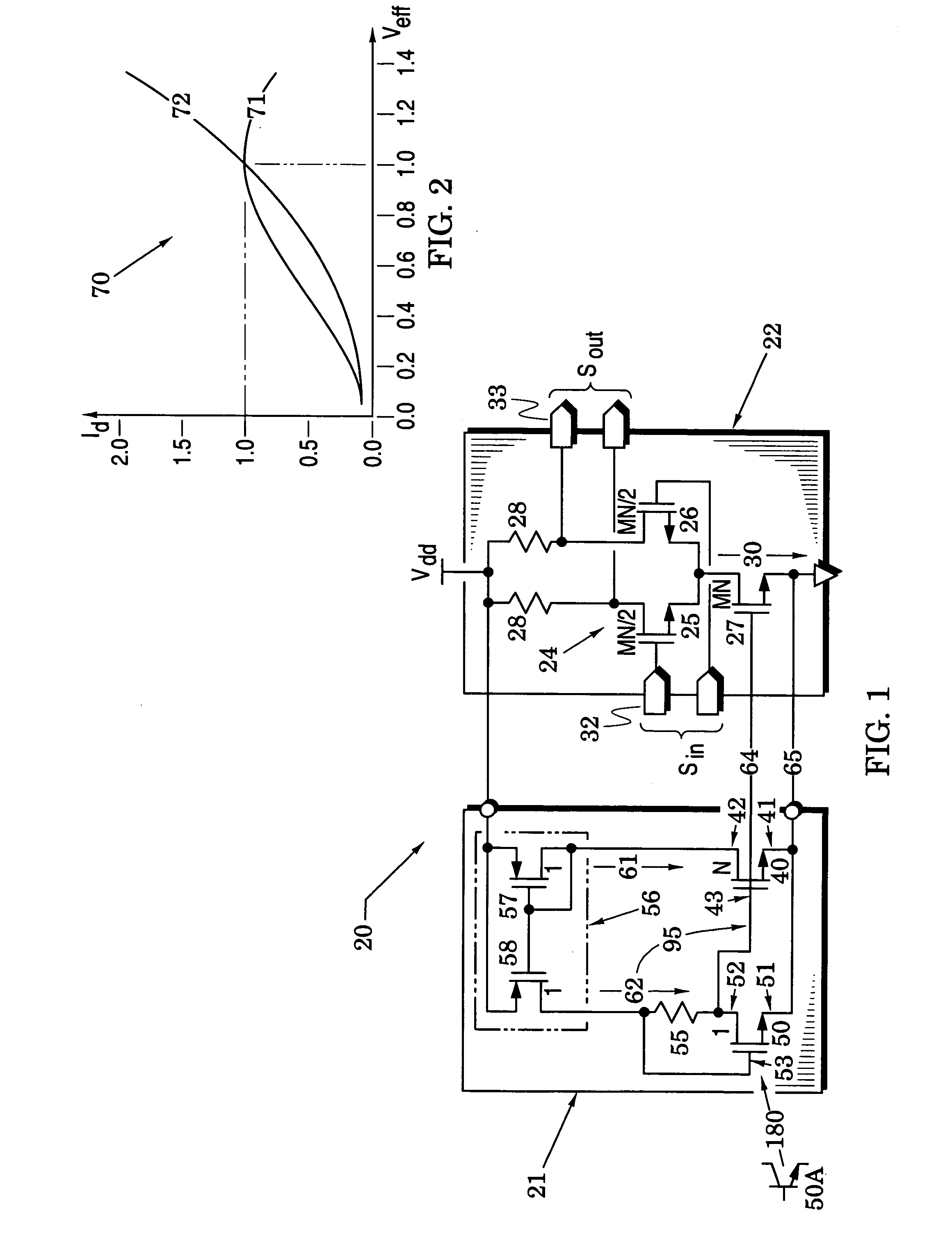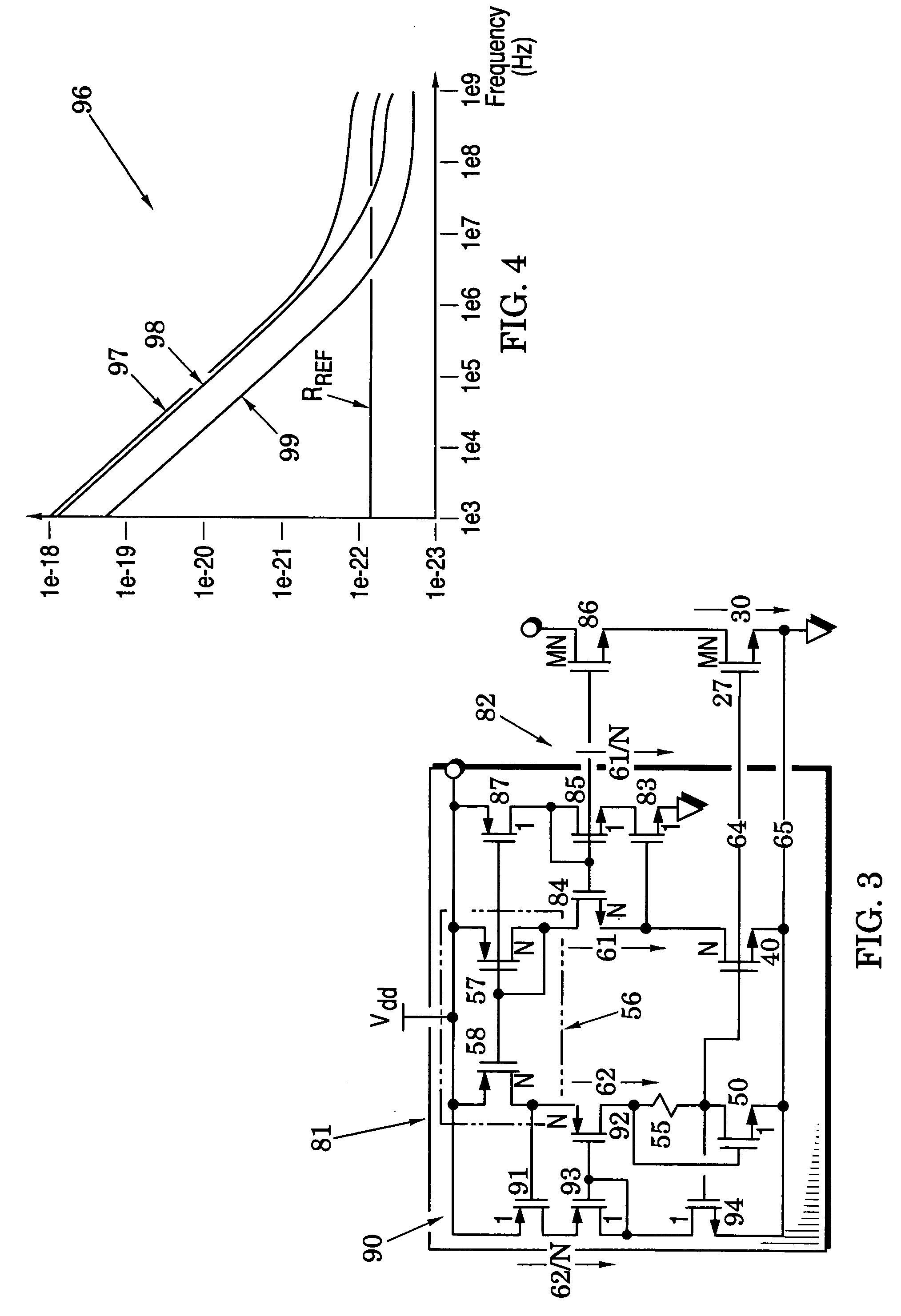Amplifier systems with low-noise, constant-transconductance bias generators
a generator and constant-transconductance technology, applied in the direction of amplifier details, differential amplifiers, amplifiers with semiconductor devices/discharge tubes, etc., can solve the problems of introducing significant errors into transistor parameters, unable to effectively control at least one contributing source of amplifier performance error, etc., to improve system performance and increase system size and/or power consumption
- Summary
- Abstract
- Description
- Claims
- Application Information
AI Technical Summary
Problems solved by technology
Method used
Image
Examples
embodiment 20
[0020]In particular, FIG. 1 illustrates an amplifier system embodiment 20 that comprises a bias generator 21 and a differential amplifier 22. The amplifier 22 has a differential pair 24 of transistors 25 and 26, a current-source transistor 27 and resistors 28. The differential pair 24 is coupled to receive a tail current 30 from the current-source transistor 27 and to differentially steer the tail current across the resistors 28 in response to a differential input signal Sin from an amplifier input port 32. Currents steered to the resistors 28 provide a corresponding output signal Sout at an amplifier output port 33.
embodiment 21
[0021]The bias generator embodiment 21 includes a bias transistor 40 that has first and second bias current terminals 41 and 42 that are responsive to a bias control terminal 43. It also includes a drive transistor 50 which has first and second drive current terminals 51 and 52 that are responsive to a drive control terminal 53. The bias generator 21 further includes a reference resistor 55 and a current mirror 56 which is formed with a diode-coupled transistor 57 and a current transistor 58 that is control-terminal coupled to the diode-coupled transistor 57.
[0022]In the embodiment of FIG. 1, the reference resistor 55 is coupled between the drive control terminal 53 and the second drive current terminal 52. The second drive current terminal 52 is then coupled to drive the bias control terminal 43. The current mirror 56 is arranged to mirror a first current 61 in the second bias terminal 42 to a second current 62 that is conducted through the reference resistor 55 to the second drive...
embodiment 100
[0060]FIG. 5 illustrates another amplifier system embodiment 100 which comprises a bias generator 101 and a complementary common-source amplifier 102. The amplifier 102 has transistors 103 and 104 with their control terminals (e.g., gates) coupled to receive an input signal Sin from an amplifier input port 105 and their second current terminals (e.g., drains) coupled to provide an output signal Sout at an amplifier output port 106. The first current terminal (e.g., source) of transistor 103 is coupled to ground and the first current terminal of transistor 104 is coupled through the low impedance (at a frequency of operation) of a capacitor 107 to ground.
[0061]The bias generator 101 includes a first drive transistor 50, a first reference resistor 55 that is coupled between a control terminal and a current terminal of the first drive transistor, a second drive transistor 120, and a second reference resistor 125 that is coupled between a control terminal and a current terminal of the s...
PUM
 Login to View More
Login to View More Abstract
Description
Claims
Application Information
 Login to View More
Login to View More - R&D
- Intellectual Property
- Life Sciences
- Materials
- Tech Scout
- Unparalleled Data Quality
- Higher Quality Content
- 60% Fewer Hallucinations
Browse by: Latest US Patents, China's latest patents, Technical Efficacy Thesaurus, Application Domain, Technology Topic, Popular Technical Reports.
© 2025 PatSnap. All rights reserved.Legal|Privacy policy|Modern Slavery Act Transparency Statement|Sitemap|About US| Contact US: help@patsnap.com



